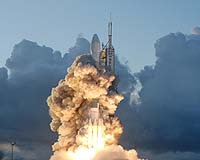 |
Madison WI (SPX) Aug 18, 2009 Grassed waterways are placed in agricultural fields where runoff water tends to concentrate because they can substantially reduce soil erosion. Mapping techniques that help identify where erosion channels will likely form could help farmers and conservation professionals do a better job of designing and locating grassed waterways in agricultural fields. Tom Mueller, associate professor in the University of Kentucky (UK), College of Agriculture, guided Adam Pike, UK graduate student, on a project that examined whether reliable prediction models could be created to identify eroded waterways from digital terrain information such as landscape curvature and estimates of water flow from upslope areas. "The terrain attributes were calculated from elevation data obtained with survey-grade GPS measurements collected on a farm in the Outer Bluegrass Region of Kentucky," Mueller explains. Results from the study are published in the September-October issue of Agronomy Journal. This work supported by a special grant from the U.S. Department of Agriculture. The authors developed equations that accurately identified the potential locations of erosion-prone areas. They found that simple regression methods could be used to fit these equations as well as more complex non-linear neural-network procedures. The equations were used to map areas in fields where erosion was predicted. These areas corresponded very well with actual field observations of erosion. This work was confirmed with a leave-one-field-out validation procedure. Research showed these maps could help conservation planners and farmers identify where erosion from concentrated flow is likely to occur, but not necessarily the exact shapes of these features. Field site-assessments would still likely be required for verification and to accurately delineate the boundaries of erosion-prone areas. Mueller stated, "while this study is promising, more work is needed to determine whether these techniques can also be used with USGS digital elevation grids and from elevation data obtained with light detecting and ranging (LIDAR) data. Further, we need to evaluate whether models can be developed to predict across larger geographic areas." Mueller is conducting follow-up research to evaluate quality of erosion predictions created with 10-m USGS data sets and evaluating the performance of these models on fields in western Kentucky. He hopes to present the results of some of this work at the 2009 Annual American Society of Agronomy Meetings. Share This Article With Planet Earth
Related Links American Society of Agronomy (ASA) GPS Applications, Technology and Suppliers
 ULA Delta II Completes 20 Year Era Of GPS Launches
ULA Delta II Completes 20 Year Era Of GPS LaunchesCape Canaveral FL (SPX) Aug 18, 2009 The 48th successful and final Air Force Delta II Global Positioning System satellite launch occurred today, ending one of the most successful space launch programs in American history. A United Launch Alliance Delta II rocket launched GPS IIR-21(M) into orbit from Space Launch Complex-17A at 6:35 a.m., EDT today. The first Air Force Delta II GPS launch occurred Feb. 14, 1989 and today's ... read more |
|
| The content herein, unless otherwise known to be public domain, are Copyright 1995-2009 - SpaceDaily. AFP and UPI Wire Stories are copyright Agence France-Presse and United Press International. ESA Portal Reports are copyright European Space Agency. All NASA sourced material is public domain. Additional copyrights may apply in whole or part to other bona fide parties. Advertising does not imply endorsement,agreement or approval of any opinions, statements or information provided by SpaceDaily on any Web page published or hosted by SpaceDaily. Privacy Statement |